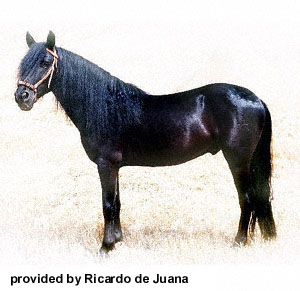|
Home Horse Breeds | First Posted: July 2, 2009 May 13, 2020 | |
Losino HorseOklahoma State University - Breeds of Livestock 
The Losino receives its name from the original area where it is bred, the Losa Valley, in the north of the province of Burgos (Spain). It is found to be related to other breeds derived from the Cantabrian-Pyrenean branch: the Portuguese Garrano, the Galician pony, the Asturian pony, the Thieldon, the Sorraia, the Navarre horse, the Basque Pottok, the Mérens horse and the extinct Catalan horse. The Losino breed maintained its number until the 50's but afterwards, and principally due to farming mechanization, the crossbreeding with meat breeds and donkey populations for mule production, its population declined to the most critical limits of its history in 1986 (around 30 animals). In this year, and due to the alarming situation, a project for recuperating the breed was established, being created in Pancorbo (Burgos) the first Breeding and Selection Center of the Losino Horse. In this center it is maintained a natural and extensive system of breeding. The animals, once captured, broken and tamed, are used for infant-junior horseback riding, harnessing, and to carry out the equestrian routes through rural and mountain zones. The census in 1,999 has reached a population of around 200 animals. Morphological Characters
Phaneroptical Characters
Eliminatory Defects According to the Losino Horse Breeding Association (1988) the eliminatory defects considered for this breed are as follow:
Contacts Spanish Losino Horse Breeding Association. (Ricardo de Juana) C/ Antecubia, NO. 6. Pancorbo (BURGOS). Telf. 947-354287Universidad de Córdoba. Dept. de Genética. Facultad de Veterinaria. Reference: Jesus Martinez-Saiz, Genetics Department, University of Cordoba, SpainAnimal Genetics Resources Information (FAO) number 19, 1996. Mason I.L. 1960. A World Dictionary of Livestock Breed Types and Varieties. Photographs Ricardo de Juana, SpainFor More Information Losino Horse -The Horse Guide |